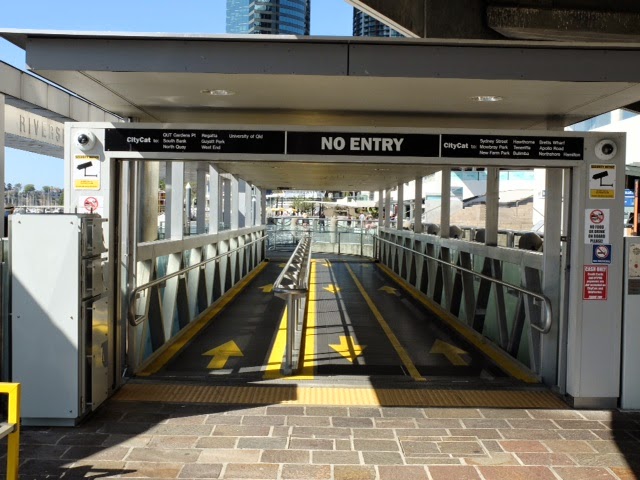Previous posts on this blog have highlighted the importance of well designed ferry terminals which allow passengers to quickly disembark and board.
Sydney's commuter wharves are the responsibility of Roads and Maritime Services (RMS), not the ferry operator or Transport for NSW, as many people might assume. RMS is in the middle of a major wharf upgrade program which will cost about $70 million. Five new wharves have already been built and a further seven are planned.
A major investment into transport infrastructure of this scale is normally made in the context of a detailed network plan covering the life of the new terminals and modelling of expected passenger movements at individual locations.
The design solution should take account of the different characteristics of passenger movements at different locations. At some wharves passenger movements are mainly one directional. Crowds either board the vessel in AM peaks or disembark in PM peaks at a commuter wharf like Mosman or Thames Street Balmain, but not at the same time.
At other places, like Pyrmont Bay which mainly serves leisure passengers, large numbers can disembark and board the same vessel. It is not uncommon for more than 100 people to disembark at Pyrmont Bay while another 100 are waiting to board. For passenger safety and to minimise dwell time, it is vital that any new wharf is designed to ensure efficient egress and ingress of passengers.
Sadly this will not happen at Pyrmont Bay. The "cookie cutter" strategy adopted by RMS in constructing previous wharves will continue at Pyrmont Bay, apparently without detailed analysis or modelling of predicted crowd movements. The recently announced wharf design shows:
- a small pontoon, similar in size to Thames Street Balmain wharf
- seating positioned longitudinally in the middle of the pontoon, which is likely to interfere with passenger egress and ingress
- no indication of how passengers waiting to board a ferry will be separated from disembarking passengers. It is probable the crowds waiting to board on a busy Sunday afternoon will extend up the ramp, blocking the exit of disembarking passengers.
At a busy terminal like Pyrmont Bay with two directional crowd movements, dwell time can only be minimised if two gangways are used, preferably double gangways. The small size of the pontoon and the positioning of fenders and seating make it unlikely that this will be possible. This means the opportunity to fix a key systemic shortcoming in the ferry network will be lost.
It is curious and frustrating that Sydney wharf design falls well short of the standards set by many other ferry networks, including Brisbane's. Here is an example of effective separation of boarding and disembarking passengers on the ramp at the Riverside ferry terminal Brisbane.



No comments:
Post a Comment